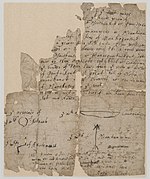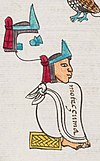Portal:Indigenous peoples of the Americas
Appearance
(Redirected from Portal:Indigenous peoples of America)
Discover Wikipedia using portals
Portal maintenance status: (June 2018)
|
The Indigenous peoples of the Americas PortalCurrent distribution of Indigenous peoples of the Americas In the Americas, indigenous peoples comprise the two continents' pre-Columbian inhabitants prior to European settlement in the 15th century, as well as the ethnic groups that identify with the pre-Columbian population of the Americas as such. These populations exhibit significant diversity; some Indigenous peoples were historically hunter-gatherers, while others practiced agriculture and aquaculture. Various Indigenous societies developed complex social structures, including pre-contact monumental architecture, organized cities, city-states, chiefdoms, states, kingdoms, republics, confederacies, and empires. These societies possessed varying levels of knowledge in fields such as engineering, architecture, mathematics, astronomy, writing, physics, medicine, agriculture, irrigation, geology, mining, metallurgy, art, sculpture, and goldsmithing. Indigenous peoples continue to inhabit many regions of the Americas, with significant populations in countries such as Bolivia, Canada, Chile, Colombia, Ecuador, Guatemala, Mexico, Peru, and the United States. There are at least 1,000 different indigenous languages spoken across the Americas, with 574 federally recognized tribes in the US alone. Some languages, including Quechua, Arawak, Aymara, Guaraní, Mayan, and Nahuatl, have millions of speakers and are recognized as official by governments in Bolivia, Peru, Paraguay, and Greenland. Indigenous peoples, whether residing in rural or urban areas, often maintain aspects of their cultural practices, including religion, social organization, and subsistence practices. Over time, these cultures have evolved, preserving traditional customs while adapting to modern needs. Some Indigenous groups remain relatively isolated from Western culture, with a few still considered uncontacted peoples. (Full article...) Selected article The United States was the first jurisdiction to acknowledge the common law doctrine of aboriginal title (also known as "original Indian title" or "Indian right of occupancy"). Native American tribes and nations establish aboriginal title by actual, continuous, and exclusive use and occupancy for a "long time". Individuals may also establish aboriginal title, if their ancestors held title as individuals. Unlike other jurisdictions, the content of aboriginal title is not limited to historical or traditional land uses. Aboriginal title may not be alienated, except to the federal government or with the approval of Congress. Aboriginal title is distinct from the lands Native Americans own in fee simple and occupy under federal trust. The power of Congress to extinguish aboriginal title — by "purchase or conquest", or with a clear statement — is plenary and exclusive. Such extinguishment is not compensable under the Fifth Amendment, although various statutes provide for compensation. Unextinguished aboriginal title provides a federal common law cause of action for ejectment or trespass, for which there is federal subject-matter jurisdiction. Many potentially meritorious tribal lawsuits have been settled by Congressional legislation providing for the extinguishment of aboriginal title as well as monetary compensation or the approval of gaming enterprises. Selected imageGeneral imagesThe following are images from various Indigenous peoples of the Americas-related articles on Wikipedia.
Selected biography Moctezuma II (c. 1466 – 29 June 1520), also known by a number of variant spellings including Montezuma, Moteuczoma, Motecuhzoma and referred to in full by early Nahuatl texts as Motecuhzoma Xocoyotzin (Moctezuma the Young), was the ninth tlatoani or ruler of Tenochtitlan, reigning from 1502 to 1520. The first contact between indigenous civilizations of Mesoamerica and Europeans took place during his reign, and he was killed during the initial stages of the Spanish conquest of Mexico, when Conquistador Hernán Cortés and his men fought to escape from the Aztec capital Tenochtitlan. During his reign the Aztec Empire reached its maximal size. Through warfare, Moctezuma expanded the territory as far south as Xoconosco in Chiapas and the Isthmus of Tehuantepec, and incorporated the Zapotec and Yopi people into the empire. He changed the previous meritocratic system of social hierarchy and widened the divide between pipiltin (nobles) and macehualtin (commoners) by prohibiting commoners from working in the royal palaces. Did you know…
SubcategoriesRelated portalsThings you can do
Selected panoramaTopics
Recognized content
Featured articlesFormer featured articlesGood articles
Former good articlesDid you know? articles
In the News articles
Associated WikimediaThe following Wikimedia Foundation sister projects provide more on this subject:
American indigenous language WikipediasAvañe'ẽ (Warani) · Aymar aru (Aymara) · ᏣᎳᎩ (Cherokee) · Chahta (Choctaw) · ᐃᔨᔫ (Cree) · ᐃᓄᒃ (Inuktitut) · Iñupiak · Kalaallisut (Greenlandic Inuit) · Mvskoke (Muscogee) · Nahuatlahtolli · Diné bizaad (Navajo) · Qhichwa Simi · Tsêhesenêstsestôtse (Cheyenne) Indigenous languages in Wikimedia Incubators: Alabama · Blackfoot · Chinook Jargon · Choctaw · Creek · Lakota · Micmac · Mohawk · Nheengatu · Northwestern Ojibwa · O'odham · Shoshoni · Unami-Lenape · Wüne pakina (Mapudungun) · Yucatec Maya · Central Alaskan Yup'ik · Zuni | |||||||||||||||||||||||||||||||||||||



